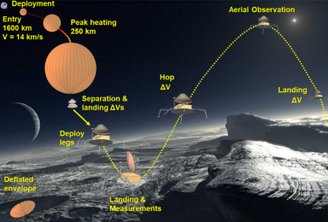Our eternal ninth planet, although now considered a dwarf planet, is always present in astronautical visit plans, whether by probes or ships. That is why ambitious projects have been developed. For the first time, Pluto will be observed not only from the sky but also with research equipment on the ground..
But how is that possible? After all, Pluto is no easy target. The icy, distant planetoid in the Kuiper Belt is 5 billion kilometers away from Earth, and depending on the position of the stars, that distance could be even greater, reaching up to 7 billion kilometers.
The distance is small, as is the intended target. The diameter of the small planet is estimated to be only 2,300 meters. An icy speck on the fringes of our solar system. Considering the distance, the size of the target, the travel time, as well as other possible difficulties along the way, So would it be crazy to think that one day we could land on Pluto?
The answer is to invest in an astronautical dream that will take decades to prove its capabilities.
Ballooning into a new world
We know it’s possible to reach our favorite dwarf planet, even if it takes a decade of travel. But there’s a problem with landing: slowing down. How can we brake an object in a low-density atmosphere that we know very little about?
While images from New Horizons are quite revealing of Pluto’s potential for landing probes and more, what type of propulsion mechanism would be most useful in this environment?

NASA has a program called “NASA Innovative Advanced Concepts” (NIAC) is where various laboratories and companies submit innovative and applicable application projects focused on the development of astronautical research.
In 2018 In phase 1, a project called BALLET featured a balloon-shaped platform that could “carry” six suspended modulesEach module would not only be the working equipment but would also be the legs of the system and enable the set to move.
In 2021, the project returned for phase 2, introducing a deceleration system that uses a balloon for constant braking, dropping the estimated 14 km/h (kilometers per second) travel speed to a soft landing speed of 120 meters per second.

For the group involved in the project, Pluto’s atmosphere, although not very dense, would be capable of creating sufficient drag forces on the balloon to allow the equipment to reach a safe descent speed.
In addition, once on the ground, the probe can be detached from the apparatus and operate without the need to drag the landing system. According to the researchers, this system will be more attractive from a financial perspective and will reduce operating costs.
Jumping on Pluto
Another interesting point of the project probe’s movement in Pluto soil: jumping! Yes, instead of treadmills, “walking” legs, or even propellers like Ingenuity, Pluto probes could hop from place to place.
The rationale for the jump lifetime is related to the atmosphere theoretically not supporting objects in flight and the low gravity, estimated at 0.62 m/s², which would allow longer and more efficient jumps in the motion of the apparatus.

Challenge for probes and men
Despite the magic and feasibility of the project, there have been some setbacks along the way. Among them: Launch windows. The probe will need to be pushed out of Jupiter’s orbit a bit to save energy and resources, achieve success, and reduce travel time.
In 2018, an optimistic launch window was calculated for 2029, but since we are still in the early days of the project, unfortunately it will not be possible to launch within five years. The next launch window is in 2042.
At least one generation will pass Thus, a new opportunity arises and the probe sent to Pluto has a chance to succeed in its journey.And even if an investigation is launched after 18 years, we will have to wait another 10 years to find out whether we have achieved our goal.
Based on these numbers we already know that: The dream of man stepping on Pluto is even more utopian. The man’s steps toward Pluto are currently discussed only in informal conversations. Moreover, with today’s available technology and the little knowledge we have accumulated during our short journeys and stays in space, it is not possible to take a man to our ancient ninth planet.
We will not say it is impossible, as technology and scientific knowledge will enable new flights towards the competent development of life maintenance even in completely hostile environments. But that day may not be today, nor in the next decade. But until then, we can continue to make great plans and build a different future.
Follow the latest developments in space technology and science on TecMundo. Take the opportunity to meet the three new sky gods confirmed by the James Webb telescope. On to the next one!
Source: Tec Mundo
I’m Blaine Morgan, an experienced journalist and writer with over 8 years of experience in the tech industry. My expertise lies in writing about technology news and trends, covering everything from cutting-edge gadgets to emerging software developments. I’ve written for several leading publications including Gadget Onus where I am an author.













